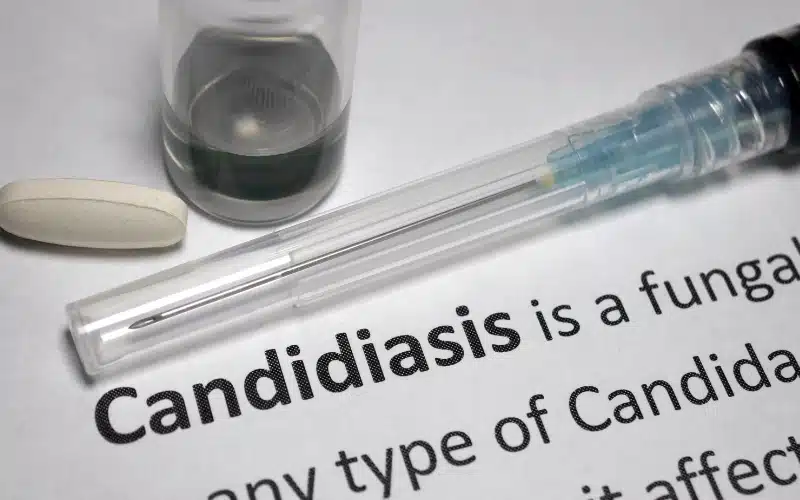Did you recently give up on alcohol or gluten-heavy food? Do you suddenly feel unexpectedly sick and crummy? If you do, you might be experiencing Candida Die-Off symptoms. It is an adverse reaction to the rapid removal of yeast Candida from the body.
Candida Die-Off is also known as the Herx reaction, short for the Jarisch-Herxheimer Reaction. It is an adverse response to the toxins released by bacteria and fungi when antibiotics and antifungal medications kill them.
The symptoms include brain fog, nausea, and headache. It feels the same as being affected by a cold and flu. One might also feel weary and exhausted, similar to seasonal allergies.
Though Candida Die-Off symptoms are alarming, it isn’t usually a cause for concern. Simple treatments can help manage these symptoms.
Quick Facts
Herxheimer reaction is a sudden reaction to endotoxins released in the body by destroying harmful microorganisms.
Endotoxins are toxic substances inside bacterial cell walls. They are released when a cell disintegrates.
Endotoxins lead to the autoimmune response of the immune system in the human body, along with inflammation. They, therefore, contribute to many natural symptoms and diseases.
Understanding Candida Die-Off

A person experiences Candida Die-Off symptoms when there is a sudden removal of Candida from the body.
Candida is a fungus in the healthy human body that helps in nutrient absorption and digestion. When present in tiny amounts, it does not cause any ill effects.
However, when the Candida microorganisms reproduce themselves, the fungal infection called Candidiasis appears throughout the body. These sites include areas of toenails, fingernails, mouth, ears, vagina, gastrointestinal tract, and nose.
This infection is called Candida and affects both men and women. It often remains misdiagnosed or undiagnosed, because the symptoms are similar to cold and flu, which may include:
- Bad breath
- Formation of a white coat on the tongue
- Craving for sweets
- Hormonal imbalances
- Brain fog
The Candida diet plan helps kill the infection. It eliminates sugar, yeast, gluten, and alcohol, as these foods promote candida overgrowth.
The diet restricts the required food supply, without which the Candida fungus cannot survive.
If someone resorts back to the diet and lifestyle that produces the overgrowth of Candida in the first place, it is possible for them to return.
However, a deficiency of Candida in the body is just as troublesome as its overgrowth. Since Candida die-off is the rapid elimination of Candida from the body, it might also occur after you abruptly switch to the Candida diet plan.
Causes Of Candida Die-Off
Candida is present in small quantities in the body as it helps absorb nutrients. Alcohol and foods containing gluten, sugar, and yeast produce an overgrowth of Candida in the body.
When a person abruptly stops consuming such foods, the Candida present in the body starves and dies off. Rapid destruction of Candida in the body produces a lot of metabolic reactions that release toxins responsible for Candidiasis symptoms.
The above leads to the Herx reaction or Candida Die-Off. It is consequently a symptom of withdrawal from alcohol or gluten.
Below are situations that may lead to Candida Die-Off symptoms, including:
- Recently giving up on foods like gluten and sugar significantly to eliminate the pathogens overnight
- Taking medications such as antibiotics and antifungals that affect the gut microbiome (a community of microorganisms grouped together)
- Recently starting an elimination diet
- Quitting alcohol
- Completing the whole 30 or another AIP elimination or a detox diet
Symptoms of Candida Die-Off

When people practice a situation that is mentioned before, they might start experiencing symptoms within weeks or months.
The most common symptoms of Candida Die-Off include the following:
- Sweating and fever
- Fatigue
- Impaired brain functions
- Infection near the liver and abdomen
- Dizziness
- Bowel movements changes
- Irritability and Anxiety
- Insomnia
- Stuffy nose
- Sinus infection
- Sore throat
- Skin breakouts
- Rashes and itching
- Swollen glands
- Chills and aches
Common Ways To Manage The Candida Die-Off Symptoms
Treating the symptoms of the Herx reaction is simple and manageable. Common practices that can help control the condition are as follows:
Implement the diet changes gradually and not overnight
Candida Die-Off goes away when you switch to a clean, healthy diet. A typical clean diet includes fruits, vegetables, healthy fats, and organic food while limiting processed and packaged food. It would be best if you slowly switched from an extreme diet to a detox one rather than abruptly.
Doctors treating Candida recommend progressively transitioning to a healthy diet with less sugar and few carbs day by day. It is more effective than suddenly going sugar and gluten-free overnight.
A clean Candida diet is all you require

Eliminating sugar, carbohydrates, and fats from your diet may leave you tempted while always wanting to return to the old way of eating. However, a clean diet, in the long run, is going to make the underlying issues of Candida fungal overgrowth reduce and give you a clean, detoxified body.
- Continue eating high-fiber, vegetables, flowers, fruit, and sugar, but in moderation
- Do not stop them abruptly
- Once you accustom yourself to the moderate intake, try reducing it to an even smaller portion
Cleansing foods to include in your gluten-free diet:
- Culture of dairy products
- Apple cider vinegar
- Spices like turmeric and cinnamon
- Manuka honey
- Green veggies
Supplements that support the immune system of the human body
Supplements can help manage the symptoms of Candida Die-Off. These include Glutathione and Alpha-Lipoic Acid.
Bentonite clay can help surround the toxins inefficiently and remove them. Molybdenum, a mineral, helps break down proteins. The other substances help convert the Neurotoxin Acetaldehyde into Acetic Acid.
Adaptogens such as Astragalus and Ashwagandha help build the body’s defense against illness, stress, and fatigue.
Final Takeaway
Apart from the eating regimen, essential oils such as lavender, clove, and oregano oil, taken internally, also help treat the body.
You can also prioritize relaxation by slowing down and avoiding things that take a toll on your mind. Keep electronic gadgets away from your side before going to bed.
Try using a sauna to take an Epsom salt bath or a Magnesium Chloride bath. Apply a heat pack with a gentle massage.
Consult a doctor if you have chronic or unusual persistent Candida Die-Off symptoms. It can also indicate an underlying illness such as Diabetes or Immune System Dysfunction.
FAQs
How long do Candida Die-Off symptoms last?
Candida Die-Off is bothersome but easy to treat. Once the treatment begins, you’ll start noticing results within three days. If the infection is severe, it may take up to two weeks.
Is Candida Die-Off dangerous?
Candida Die-Off seems frightening as the symptoms appear suddenly, but it is not dangerous. Simple treatments and precautions can help relieve the symptoms in a few days.

